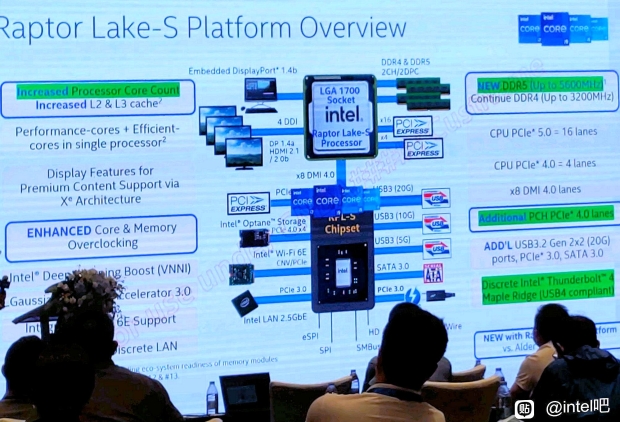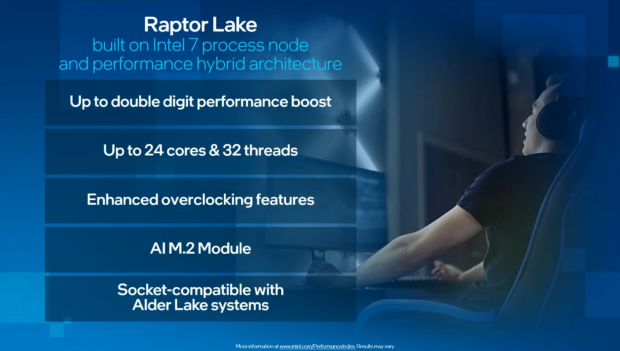Intel Raptor Lake-S CPU platform: DDR5-5600 support, 16 PCIe 5.0 lanes
Intel's new 13th Gen Core 'Raptor Lake' CPU platform details: DDR5-5600 supported, PCIe 5.0 = 16 lanes for GPU, no PCIe 5.0 SSDs.
Intel's new 13th Gen Core "Raptor Lake" CPUs are a few months away yet, but we've got previews and reviews out already, and now some more details are coming out from a presentation held in Shenzen, China, by Intel this week.

The meeting itself saw Intel focusing on NAS products and other roadmaps, but there was a slide that Intel had up titled "Raptor Late-S Platform Overview" with some new details. The slide teases that Intel's next-gen Raptor Lake-S will support DDR5-5600 memory officially, a big jump over the current 12th Gen Core "Alder Lake" CPUs with support for DDR5-4800 (the JEDEC default for DDR5).
Not only that, but the slide also means that Intel's upcoming Raptor Lake CPUs will have support for DDR4 memory, with up to DDR4-3200 supported. Intel's current-gen 600-series chipset and its associated motherboards have SKUs with DDR4 or DDR5 memory, so it looks like we can expect the same for the upcoming 700-series chipsets: motherboards with either DDR4 or DDR5 memory.
- Read more: Intel Z790 rumored PCIe 5.0 SSD support, ready for Raptor Lake CPUs
- Read more: Intel's next-next-gen Z790 chipset with Raptor Lake CPUs in Q3 2022
- Read more: Intel Core i9-13900K processor allegedly on sale, hits black market
- Read more: Intel Core i9-13900K 'Raptor Lake' CPU: 68MB of L3 cache spotted
My attention is with the PCIe 5.0 lanes on the Raptor Lake-S platform overview, where Intel says that the CPU will have 16 lanes of PCIe 5.0 and 4 lanes for PCIe 4.0. Intel does note "additional PCH PCIe 4.0 lanes" on Raptor Lake.
This means that if you have a juicy new, next-gen PCIe 5.0-capable GPU that uses 16 lanes of PCIe 5.0, you won't be able to have a new PCIe 5.0-capable SSD at the same time. Well, you will... but the PCIe 5.0 GPU will be sharing the 16 lanes of Gen5 goodness with the PCIe 5.0 SSD.

We won't know if you'll need all 16 lanes of PCIe 5.0 on a next-gen GPU to pull everything from it -- but you sure as hell don't need 16 lanes of PCIe 4.0 to enjoy the best GPUs using that standard -- AMD's fastest Navi 21-powered Radeon RX 6950 XT graphics card, or NVIDIA's new GA102-based GeForce RTX 3090 Ti graphics card. They'll perform beautifully, even on PCIe 4.0 x8 with 8 lanes, down from 16 lanes.
- Read more: AMD Navi 31 GPU: flagship Radeon RX 7000 series uses PCIe 5.0 x16
- Read more: Phison teams with AMD + Micron for PCIe 5.0 NVMe SSDs of the future
- Read more: AMD X670E chipset: ready for AM5 CPUs with PCIe 5.0 for GPU + SSDs
If you want to use a full-speed PCIe 5.0 SSD then you'll need 4 lanes for the most part, until you start using bigger RAID cards and wanting to drive something like Sabrent's everything-destroyer in the new Rocket 4 Plus Destroyer 2 SSD. That beast brings up to 64TB of SSD speeds at an insane 28GB/sec speeds... all over PCIe 4.0 x16.
- Read more: Sabrent Rocket 4 Plus Destroyer 2 SSD: 64TB SSD @ 28GB/sec insanity
- Read more: Phison teams with AMD + Micron for PCIe 5.0 NVMe SSDs of the future
- Read more: Phison teases its next-gen PCIe 5.0 SSD controller, handles 10GB/sec+
- Read more: Phison talks next-gen PCIe 5.0, PCIe 6.0, PCIe 7.0 SSDs of the future
- Read more: Phison's next-gen E26 PCIe 5.0 SSD controller: 16GB/sec read speeds
If you're using a next-gen Gen5-capable SSD on PCIe 5.0 x4 (4 lanes) then you'll enjoy up to 15-16GB/sec reads out of next-gen SSDs. Using the full 16 lanes on a PCIe 5.0 x16 slot will deliver up to 64GB/sec on next-gen SSDs of the future (in RAID cards like Sabrent's new Rocket 4 Plus Destroyer 2 SSD).



